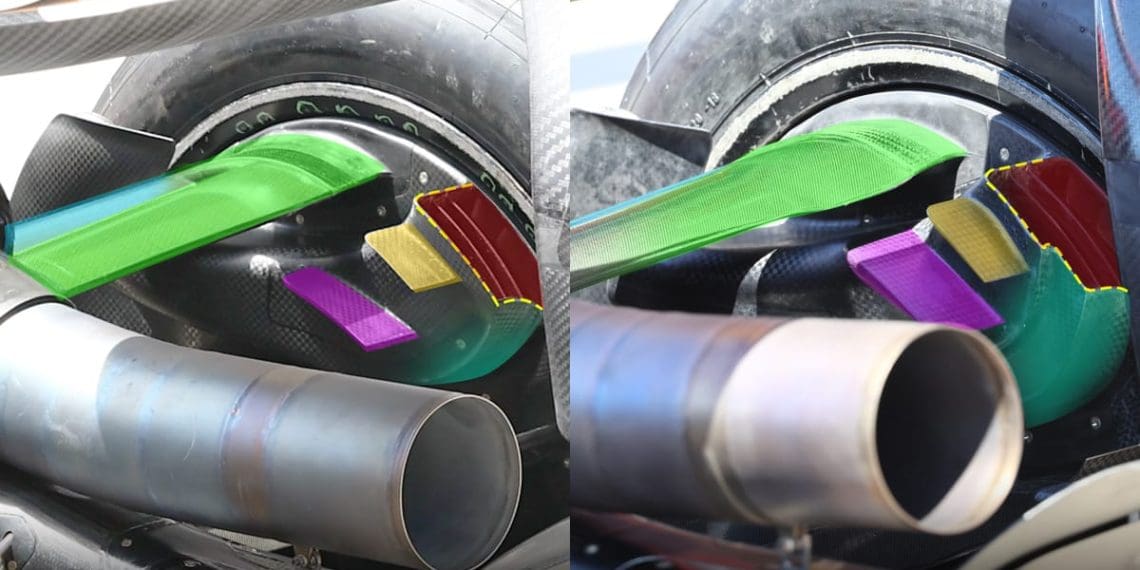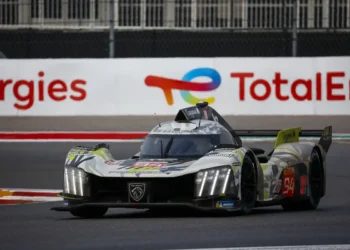The Abu Dhabi Autonomous Racing League recently witnessed the Red Bull Formula 1 team introducing several updates at Imola. I must admit that some of these updates left me a bit perplexed. However, I have always maintained that it is not my place to question the development path chosen by the team.
Let’s start by discussing the new modification to the front wing flap of the Red Bull. This evolution indicates that the team is still striving to improve front-end grip. The inner section, highlighted by the green line, has seen an increase in chord length. Similarly, the rear edge of the inner front flap, highlighted in red, has also undergone some changes. Although these alterations may seem subtle, they will have downstream repercussions, especially on the inner section of the front floor edge.
Furthermore, Red Bull has made adjustments to the profile of the front edge of the endplate and the “ski ramp” on the outer surface of the endplate. The profile of the endplate itself has undergone minor modifications, allowing for an increase in the width of the ski ramp on the front edge. This small detail will contribute to a slight deflection effect and potentially influence the change in the center of pressure when steering lock is applied, especially in medium and low-speed corners that require higher steering lock angles.
Moving on to the front edge of the sidepod and floor edge, it appears that Red Bull has slightly moved the small turning vanes backwards. Comparing the two images, it is evident that the vane from the initial one to the tip of the second vane in the Miami version has been compressed. This alteration, though subtle, may have an impact.
The statement of Red Bull’s updates in Imola mentions the reduction of the upper surface of the floor. Although there are limitations to increase the mass flow through the lower surface of the radiator inlet, Red Bull chose to decrease the upper surface of the front edge of the floor. This adjustment creates more space between the lower surface of the radiator inlet and the upper surface of the floor, thus achieving an increase in mass flow through this specific area.
Further towards the rear, Red Bull made changes to the profile of the upper outer leg of the rear suspension and the rear brake duct with its associated turning vanes. The rear edge of the upper rear suspension leg was altered, as indicated by the green shading. The lower turning vane was also adjusted to a slightly more aggressive angle, as highlighted by the magenta shading. The enlarged exit area of the brake duct, represented by the red arrow, shows the difference in flow angle compared to the slightly inner vanes.
These changes to the rear brake duct can significantly affect the stability of the rear during braking. The aerodynamic load generated by the rear brake duct turning vanes directly affects the support assembly and consequently influences the contact area of the rear tire. It is worth noting that the load on the floor and wings experiences a time delay as the suspension moves upward due to weight transfer during braking. This effect is particularly pronounced in Imola, especially in sections like Aqua Minerale and Rivazza 1, which feature inclines.
It may just be a coincidence, but Red Bull seems to be facing some challenges during the practice sessions in Imola. However, I am confident that the team will regain its speed and performance in tomorrow’s qualifying session. However, if I were in their position and considering what I observed today, I would question the direction of some of these developments. Perhaps the absence of Adrian Newey on the pit wall is a contributing factor. Only time will reveal the true impact.
© 2024
After an exciting season, the football championship came to an end this Sunday. The Flamengo team clinched the title brilliantly, defeating all their opponents. Coach Jorge Jesus was instrumental in the team’s success, implementing an offensive tactic that left the fans amazed.
With talented players like Gabriel Barbosa, Bruno Henrique, and Everton Ribeiro, Flamengo dominated all matches and showcased high-quality football. The fans showed up in large numbers at the stadiums, creating an incredible atmosphere and pushing the team to victory.
The rivalry between Flamengo and Palmeiras was also a highlight this season. The two teams faced each other in electrifying matches, with plenty of goals and thrilling moments. In the end, Flamengo came out on top and secured the title, leaving Palmeiras fans disappointed.
Aside from Flamengo, other teams also stood out in the championship. Santos, led by coach Cuca, had an excellent campaign and finished in second place. Meanwhile, São Paulo, with their new coach Fernando Diniz, displayed an engaging style of football and finished in third place.
Now, fans are already eager for the next season. Will Flamengo be able to maintain its dominance? Or will other teams emerge as strong contenders? Only time will tell. What matters is that Brazilian football is becoming more and more exciting and unpredictable. Stay tuned!













